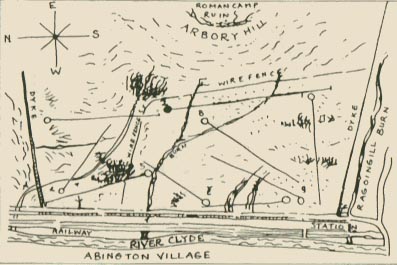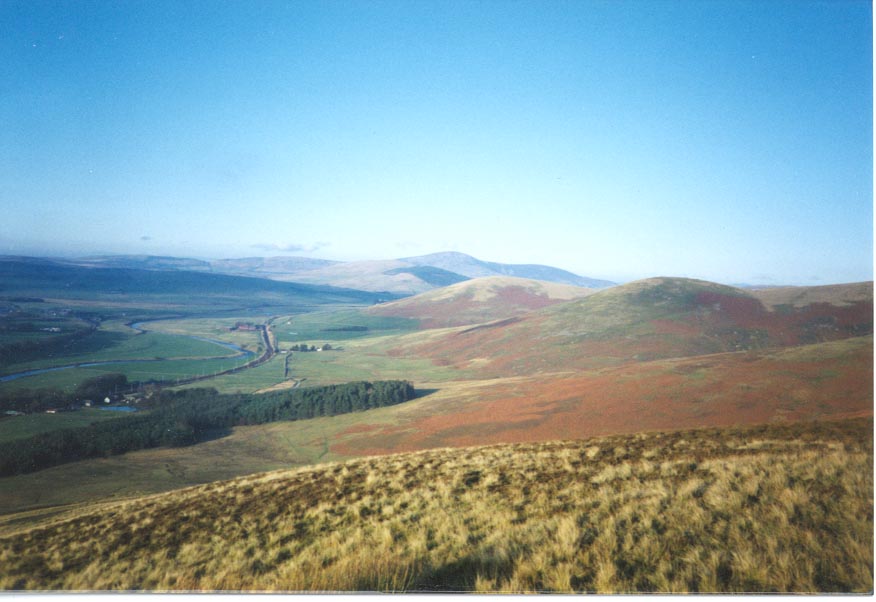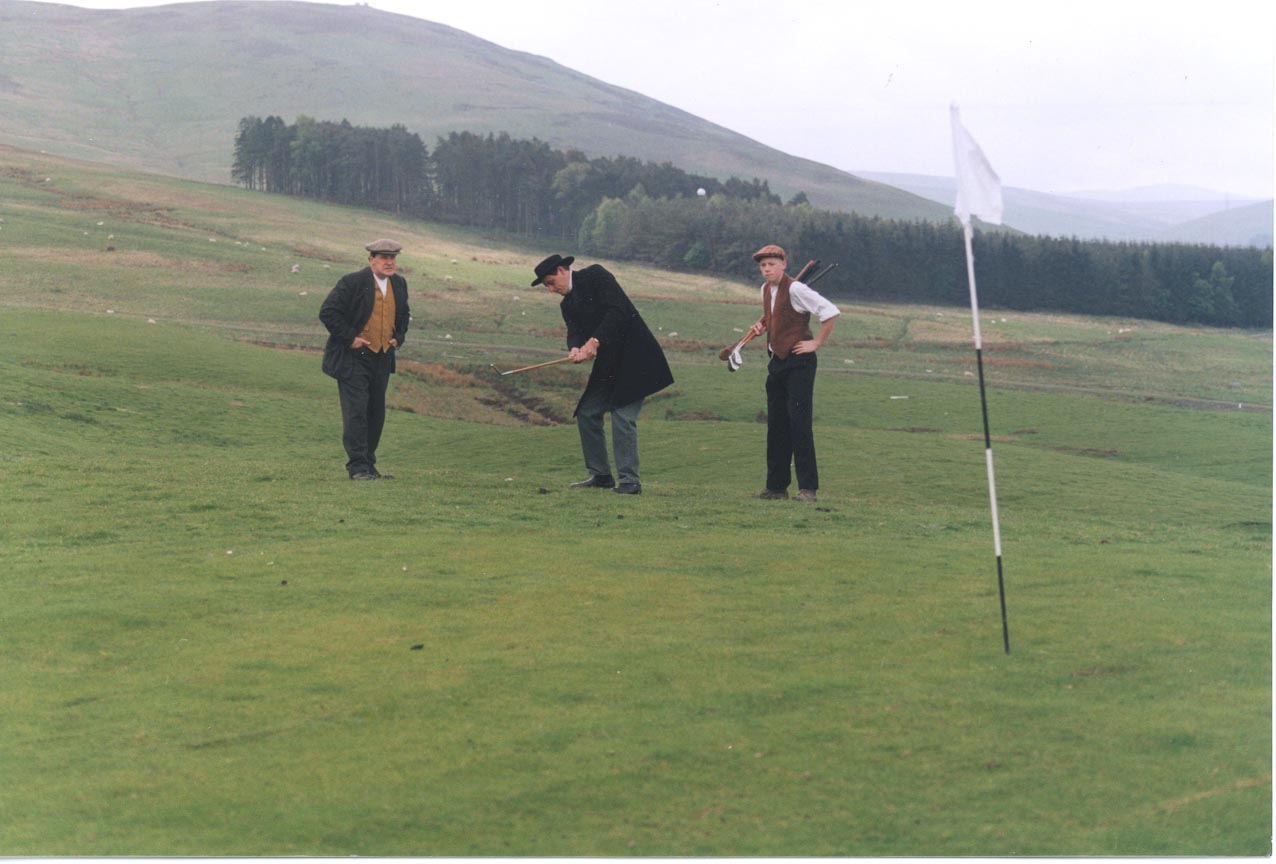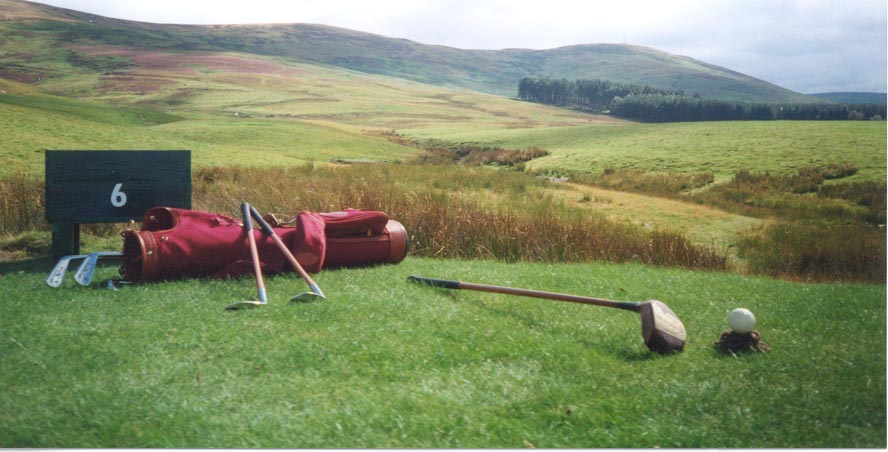Arbory Brae Golf Course, Scotland
by Alfie Ward
Introduction
My name is Alfie Ward, and along with my brother Harry, we have finally managed to complete the reconstruction of Arbory Brae golf course in South Lanarkshire, Scotland. Any further reference to the district will be described in it’s historic title of ‘Clydesdale’. The entire project has been self funded. All our attempts to secure funding have been rejected to date, which has caused serious problems and leaves the mission, as yet, incomplete. Although the course and Pavilion are as right as they should be, we feel our customers deserve better in various other areas of service and comfort. Any deficiencies we have at present, can only be remedied once the business starts to pick up.
Within the four years of reconstruction, we have been privy to a diverse education in nature and golf course creation. We hope that others may find their own hidden gem, and take to the challenge as we have.
Layout

Original sketch of the layout.
The original course was laid out in 1892 by Willie Fernie of Troon, The Open winner of 1883. As was the norm for these pioneers of golf course architecture, Fernie would probably have arrived by train, be refreshed with tea and scones, and then be shown the ground upon which another inland golf course would be born. Having surveyed the 25 acres of rolling ground below Arbory Hill, the actual laying out of the 9 holes would have then commenced. Accompanied by a few committee members armed with wooden stakes and a mallet, Fernie would have simply walked, and led the committee giving instructions to the placement of tees and greens en route. No doubt his professional judgement would be fully explained, and justified, between stopping points to these new disciples of golf.
Having finished where they started geographically, ensuring an easy link from 9th green to first tee “ the task was deemed fait accompli. A fairly straight forward and simple process for people now labelled historically as, ‘golf course architects ?’
Of course, they were architects of golf, but in a totally different timescale and dimension from our modern equivalent. Courses were laid out in such a way as to avoid any high and unnecessary expense. Some courses were never constructed in line with the original advice, entirely because of the financial outlay involved ! The committee would then have two options “ get another pro and pay another fee, or do the job themselves using the newly found knowledge they had picked up from the professional. The latter was usually the path taken.
However, I do not intend to demean the early pro’s contributions to golf course architecture as this would be wrong to do so. There was a great craft employed using certain principles of 19th century golf and what was expected of a course at that time. Blind holes were a constant feature in many layouts as this was deemed as “ ‘A test of manhood’ to the golfer. Nature was fully exploited by incorporating her natural hazards at every strategical point on the course. And distance factors were critical on each and every hole. The professional had the responsibility of extracting the maximum possible benefit from each individually unique piece of land put before them
Knowing every square yard of Arbory Brae golf course, I doubt if anyone could have created a better layout on this piece of land, than Fernie’s masterly interpretation of the ground in 1892 !
The Hazards
The hazards at Arbory are all entirely natural and totally in keeping with an early Inland course. There are no sand bunkers, as they belong on the seaside links courses where the subsoil is essentially ‘sandy’. Inland courses had a tendency towards constructing ‘Grass Bunkers’ to protect greens. Sand bunkers were introduced to many inland courses going into the early 20th century. After they had been excavated, they were filled by sand from the nearest quarry which was often found to be unsatisfactory for the purpose. Drainage was another problem with these early man made bunkers, as they often neglected to make any provision for our wet weather “ and they simply filled up with water !
Bull rushes, bracken, and a network of shallow ditches form the backbone for Arbory’s defences. Any foozled shot will usually meet a very penalising result ! The fairways “ what fairways ? There are no fairways, just open ground where a beautifully executed shot can still find an awkward lie at the base of a ‘grassy knoll’, or where the ball comes to rest on a ‘sheep track’ ! Cart tracks were also evident on other early courses.
There are, of course, the other unwanted hazards which golfers had to contend with, viz ; borrowing animals. Rabbits and moles have always been an irritation to the golfers pleasure “ and the trend continues to this day ! The green keeper, that’s me, has become very proficient at trapping the moles and the ground is 100% free of these nasty little excavators of land.
Mother nature provided all the hazards for golf “ and so it remains at Arbory Brae. But she can be a bitch at times !
The Ecology

An elevated view from a nearby hilltop.
Arbory Brae is set amidst the rolling hillside slopes of Clydesdale (now South Lanarkshire), in southern Scotland. Sitting at the foot of Arbory Hill from which it takes it’s name. Arbory, suggesting arboreal, but there are no trees on either the course nor Arbory hill itself. The 25 acres of ground is, I believe, the perfect location for the participation of a game of golf ! Ben Sayers made several visits to Abington and was quoted in 1893 as saying ; ‘I have never seen a place so well adapted, so pleasantly situated, and in every way so suited for the purpose ‘.
The land is essentially non arable due to the subsoil being very stony beneath a thin layer of turf and topsoil. A very disappointing and poor combination for the farmer “ but a treasure for the inland golfer before the invention of the mower ! The fact that the ground is so agriculturally poor at Arbory, has been our saviour in knowing that man has never put it to the plough and altered it’s image for centuries.
A definition of the course proves slightly difficult. It has similarities to that of a Heathland course “ but not quite. Nor can it be described as being a Moorland type. An exact definition is beyond a layman on the subject, such as I. I can say, however, that the variety of species which constitutes the turf at Arbory, give the perfect playing field for the game of golf, whether it be 19th century “ or 21st !
With the provision of ample grazing especially for the summer months, the only grasses cut on the entire course, belong to that of the tiny greens. (the turf will be analysed this summer by one of our ecological members)
The greens average in area, under 90 square yards each and consist of imported sports turf from the north of England. The reasons being, that a compromise was thought necessary for the modern golfer. And also due to the fact that the original greens were unrecognisable and had to be scraped level and repaired very quickly.
Small wild flowers grow liberally throughout spring, summer, and autumn with the most common being the wild Pansy.
A plethora of fungi and mushrooms appear during spring and autumn. Although we have scanned the entire 25 acres at these times of the year, we have yet to find the Magic mushrooms !
Birdlife in the area includes ; Buzzards, Kestrels, Magpies, Thrush, Larks, Heron, and other common species.
A family of wild stoats are frequently seen playing along the boundary dykes and have taken full residence on the course. Foxes have also been seen wandering down from the hills.
The sheep are, of course, our most important occupiers of the land and May “ June sees the introduction of new life courtesy of the lambing season.
The course also contains two small fresh water ponds which will serve as a reserve in the event of drought. (some chance !)
The History

Picture of Harry, Alfie, & my son Ross.
Scotland’s reputation as being ‘the hame O’ gowf’ is internationally recognised, and quite rightly so for many reasons. We are, indeed, very fortunate in having this wealth of historic information and facts at our disposal. But golfing history IS international, and Scotland should not be seen as being the sole claimant ! Every corner of the world now has it’s own golfing history to be proud of.
At Abington, the customer receives, quite naturally, a very Scottish version of where golf has come from, and to where it may be going ? The subject matter is sometimes obvious “ Morris, Park, Braid, et al. Some may even say that they’ve heard it all before, and perhaps they have. But there awaits the ear of learning “ a history of the game as yet untold !
Through nearly 10 years of dedicated research mainly concentrating upon the Clydesdale area where we live, we have accumulated our own wealth of facts and details which highlights some of the most important people ever to have played the game. That is, the founder members of each and every golf club. And those golf clubs’ are worldwide !
Arbory Brae golf course and it’s modest little Pavilion, is the living proof of ‘grass roots’ golf in Scotland. Golf is not just about the famous, it’s about every single person who has, or will, contribute in some way to the game’s progression and success. We can tell of Clydesdale’s part in that story and pay tribute to ‘our’ pioneers of the Royal & Ancient game. A tribute to those who created golf “ ‘for them and theirs !’
Hopefully, people from other nations will realize that perhaps, they too, have a story or two to tell from an untapped source in their own backyard ?
So, at Abington, the customer can expect an extemporaneous (phew) version of events from a variety of themes, which every golfer can relate to and discuss freely. Some factual, and some opinionated.
Perhaps YOU will pick our brains some day.
An Opinionated Account of Technology

And now we enter into the latest in a long line of controversial topics which have centred themselves round the R & A game. The issue of Technology in golf ?
One of the main factors we should be aware of, is that this particular issue is ‘Old Hat’ and that the game has been confronting, and skipping over these hurdles of evolution for the past 150 years “ or more ! From Feather to Gutta Percha, to the Haskell, and now the ill named Bullets of the 21st century !
The advancements in all our day to day lives courtesy of new and marvellous technologies, cannot be disputed. But where do we draw the line when it comes down to the preservation of a game called golf ?
The history of golf emits lessons of negativity and caution when related to new technologies. We ‘have’ been here before “ the Déjà vu experience, if you like. And only fools ignore the evidence of our past mistakes !
When Gutta Percha was surpassed by the introduction of the Haskell in 1898 – 1901, we were given all the evidence we should need in order to provoke thoughts of caution for the future. Although regarded as a marvellous advancement and asset to the game in it’s time, the Haskell would prove to be a Jeykll & Hyde character. Not to be regarded as a mistake, but an improvement to the golfers pleasure derived from the game. It must have been a fantastic boost to any golfer who instantly received an early Xmas present of between 20 “ 30 yards off the tee. The feel factor too ! As anyone who has tried to master the intemperate flight of a real gutta percha ball will tell you. The Haskell was indeed a joy to behold and ye olde gowfers must surely have been on cloud nine with it’s discovery.
But for such joys, there is usually some sort of price to pay. And that price was to be the devaluation of every single course which had been created on God’s green earth ! It was not long before every green keeper was given his instructions to defend his course from the humiliation of the 20th century, modern golfer.
The first, and financially preferred option, was to simply extend all holes now regarded past the sell by date. This entailed the construction of new tees where possible, and on average extending that hole by 20 “ 50 yards. (ever wonder where all the ladies tees came from on some courses ?) Strategic placement of new bunkers was another option available. But when all else failed, it became necessary to construct entirely new greens, which was both time consuming and expensive. Sometimes a perfectly good par (or bogey) 4, would be reduced to a 3.
And so, technology in golf had taken the game to a new level and it’s consequences meant that many courses would fail to keep up with times, became old fashioned and less challenging, and often fell by the wayside altogether ! That’s life, as they say, and golf has continued with this ‘tit for tat’ progression for a full century now. But wait ! Oh no ! It’s 2002 AD and man has played golf on the moon ! Soon the game will become truly international as we cross neighbouring borders in order to reach the next green ?
An exaggeration, of course. But what is this I hear from the keepers’ of that great annual spectacle at Augusta National ? The course is ready for The Masters “ but don’t expect us to extend any further !
The warning signals have been sent out from various sources in recent years of which I am proud to admit to being a contributor. To the experts who knew better, I utter these words on behalf of all the nutty golfers in the world “ ‘We told you so !’ (where have all the par 5’s gone ? long time passing ¦ ¦.) And a famous golf ball manufacturer may take the (p***) mickey as much as they like. But in reality, they are inadvertently culling every great course on the planet in order to satisfy the ego’s of the modern golfer and not to mention the financial gain that follows.
What golf is crying out for right now, is a modicum of honesty and restraint from our governing bodies, the manufacturers of equipment, and none least “ from the golfers themselves !
Jack Nicklaus, Nick Faldo, and just recently, Ernie Els, have all made statements regarding concerns for the game’s future. There is no need to take the game back 100 years “ 20 years will do !
The End







